|
||||||||||
|
|
||||||||||
|
||||||||||
|
|
||||||||||
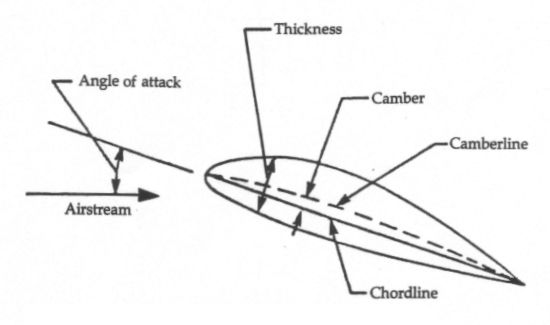
Note that the direction of the air stream is drawn as being level while the airfoil is tilted upward. Illustrations like these often lead people to believe that angle of attack is the attitude of the vehicle with respect to a level surface. However, it would be just as valid to draw the same image with the airfoil level and the direction of airflow inclined at some angle.
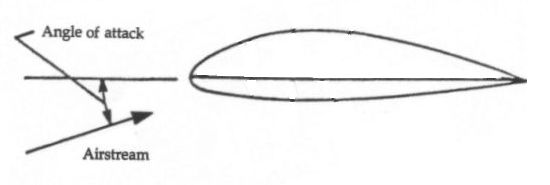
In addition, the same situation could be presented with neither the airfoil nor the airflow level, but both at some arbitrary angle.
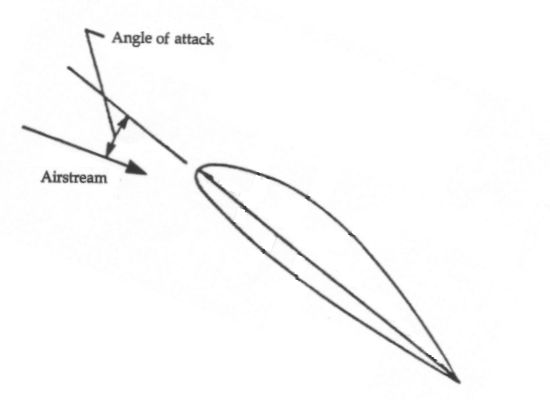
Nevertheless, the airfoil remains at the same angle of attack in each of the three cases shown above. Why? The explanation is that angle of attack is not measured from a level plane but is defined as the angle between the airfoil chord line and the relative wind. The relative wind is a term often used in aerodynamics describing the direction at which a vehicle in flight meets the oncoming air stream.
A more technically correct term we can use in place of the relative wind is freestream velocity, often represented by the symbol V∞ (pronounced "V infinity"). Freestream velocity is defined as the velocity of the airflow far ahead of the aircraft such that the air is not affected by the motion of the vehicle through it. Angle of attack, denoted by the Greek letter α (pronounced "alpha"), is defined as the angle between the chord line of the aircraft's airfoil and the freestream velocity vector, as illustrated below.
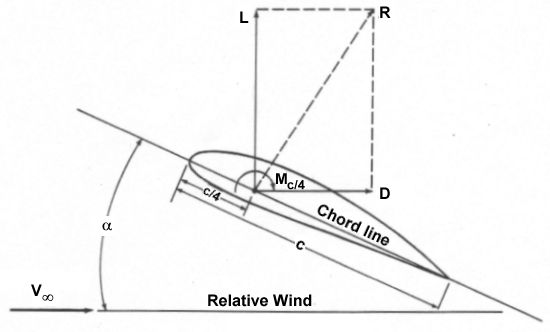
It is very important not to confuse angle of attack with other commonly used angles in aviation. One of these common misconceptions is the confusion between angle of attack and angle of incidence. On many aircraft, like that drawn below, the wing is inclined at some angle to the plane's fuselage.
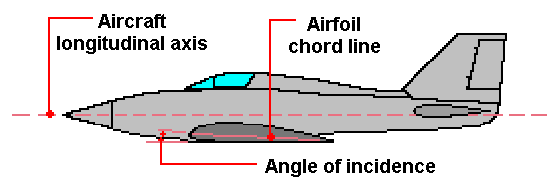
We measure this angle between an axis running the length of the aircraft, called the longitudinal or x-axis, and the chord line of the wing airfoil and call this value the angle of incidence. The angle of incidence is usually fixed for any given aircraft and never changes.
Another key angle that is most often confused with angle of attack is called the aircraft pitch angle. Pitch angle is one of three angles that are called Euler angles. These three angles define the orientation of the aircraft in roll, pitch, and yaw with respect to a fixed reference coordinate system.

Most often, the angles are referenced to the surface of the Earth. The pitch angle is defined as the angle between the longitudinal axis of the aircraft and the horizon. Pitch is usually represented by the Greek letter θ (pronounced "theta"). The following picture illustrates the definitions of angle of attack α, measured with respect to the velocity vector, and pitch angle θ, measured with respect to the horizon.

Some further examples are also provided illustrating the key differences between these two important angles. The first set of examples shows three airfoils all at the same angle of attack but at different pitch angles. This situation demonstrates that a wing can easily be at the same angle of attack even when flying much different maneuvers, such as climbing or descending through a loop.

The second set of examples shows an airfoil at different angles of attack that are always equal to the pitch angle. This scenario is also quite common. During level flight, for example, an aircraft may cruise at different speeds. Lift varies with both speed and angle of attack, as demonstrated by the lift equation. As speed decreases, therefore, angle of attack must increase to maintain the same lift and the same cruising altitude.

We hope that this explanation has cleared up any misconceptions you may have about angle of attack because
understanding this subject is vital to understanding aerodynamics. Angle of attack is one of the most fundamental
and important quantities in aerodynamics, if not the most important. Other values like lift and drag depend on
angle of attack, as demonstrated by many of the topics we have previously written about. If you understand and can
appreciate the significance of angle of attack, you will be well equipped to comprehend many of the other
fundamental concepts of aerodynamics.
- answer by Jeff Scott, 29 February 2004
Read More Articles:


|
Aircraft | Design | Ask Us | Shop | Search |

|
|
| About Us | Contact Us | Copyright © 1997-2023 | |||
|
|
|||